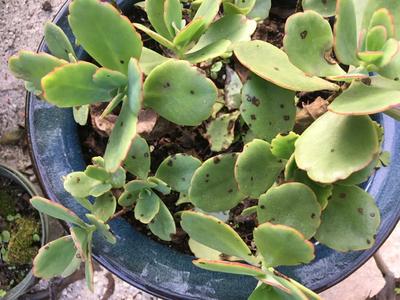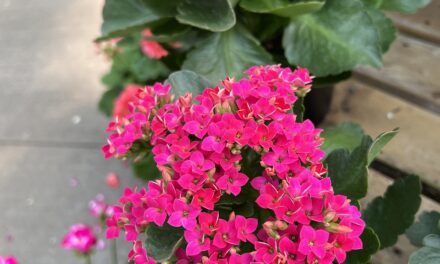by Sandi
(High Springs, FL)

Outside container stock. Shows problem clearly
I work for a woman who is 5 years into her succulent business
Rooted stock in containers both outside and in greenhouse
Zone 8b
N. Central Florida (Gainesville)
Sales of cactus and succulents both in container garden’s and grower pots
I do propagation as much as I can. My greatest concern is the brown spots that appear on most of our leafy plants: echeverias, kalanchoe, jades etc. We only use and sell perfect products. Although I’ve been quite successful in my propagation, I have been widely unable to raise an unblemished plant.
Any help would be so appreciated! My boss says it’s because they’re just old plants😕
Thank you,
Sandi Gardner
High Springs, FL
Comments for Brown spots
Dec 15, 2019
Anthracnose
by: Jacki Cammidge, Certified Horticulturist
Anthracnose is a really funny name for a not very funny disease. This plant looks like it’s riddled with it. Anthracnose is a fungal infection.
This is what e-How says about it;
Anthracnose, a fungal disease with symptoms characterized by circular, pale, sunken or brownish spots, causes plant tissues to dry up and become stiff like bark.
Brown leaf spots with yellowish margins on the leaves can be caused by several fungal diseases. Some spots will have a target pattern or a concentric ring. The fruiting bodies of fungi look like small black dots and are visible in dead plant tissues. The fungi can continue to survive in dead or decaying plant matter in the soil and this can cause reinfestation in existing and new plants.
If this is what your plant’s leaves look like in magnification, then you have Anthracnose.
Treatment for Anthracnose;
If you, like me, resist resorting to chemical solutions, this is what I do; Anthracnose, and other fungal issues, rely on certain conditions to propagate themselves; temperature, humidity, and a certain pH. So change one or more of those things. Plus, get rid of the infection!
Pick up all the dead leaves, or go the extra mile and remove the diseased ones from the plants. Fallen leaves will continue the infection, and although it’s a lot of work, this, in the long run, will be most successful.
Keep in mind that this could disfigure the plants and make them unsellable in the short term, but it will cure it. It won’t take long for them to make new leaves to replace the ones you remove.
So get busy, use a pair of long scissors (I like my bonsai scissors best) and cut off the diseased leaves – dispose of them, don’t compost them.
Then, to make sure it’s not going to recur, spray the plants and the surface of the soil with baking soda mixed with water. This will change the pH.
You also might consider the humidity where you’re growing them, and give them more ventilation. This prevents moisture from staying on the leaves.
Avoid spraying the leaves – some kind of wicking system or drip irrigation works better than overhead watering for succulents.
And, use a really well drained soil. I use Sunshine Mix #4 which has added aggregate, plus a water holding polymer, which allows the soil to re-wet even when it’s bone dry (which I recommend).
Hope these suggestions will help get your crop back on track!



